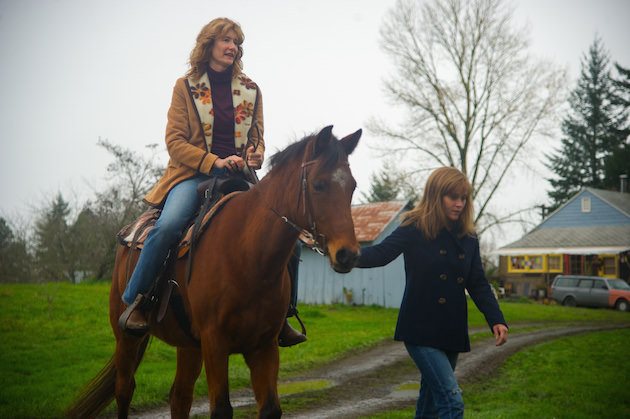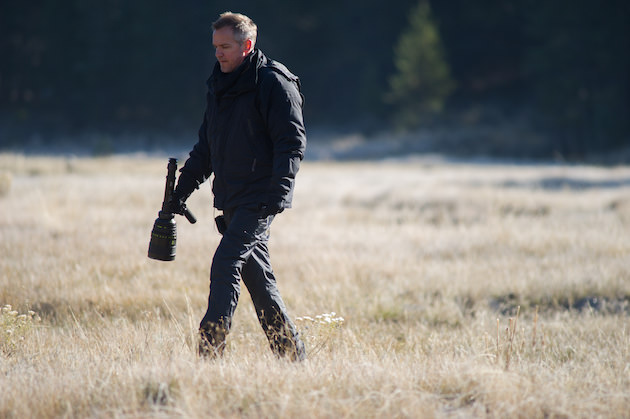A Woman Goes Into the Wild
In the search for more female lead roles in Hollywood, Reese Witherspoon provides a guide map of how to do it—all while garnering Oscar buzz. In Wild, director Jean-Marc Vallée and Academy Award nominated screenwriter Nick Hornby bring the true-life story of Cheryl Strayed’s 1,100 mile hike (in truth, it was more than double that with all the switch-backs) along the Pacific Crest Trail (PCT) to through a raw performance by Academy Award winner Reese Witherspoon. The film, which could put Witherspoon’s name back in the pool once again for an Academy Award nomination, takes viewers on the journey of a woman coming to terms with her past, including the death of her mother and her drug addiction, while struggling to change the course of her future. But it’s Witherspoon’s role both behind the scenes and in front of the camera that may be changing the course for women in films.
Epic wilderness sagas have been a part of our cinematic DNA for years. The one key component in that DNA has remained the same over time: a leading man. From the 1912 silent film The Conquest Of The Pole, to Robert Redford 1972’s Jeremiah Johnson, it has always been man versus nature, and in the stories of people plunging into the wild, be it the wilderness or the ocean, the tales have long traced the excursions of men and only men. Throw in Emile Hirsch in Into the Wild, James Franco in 127 Hours and Redford again in last year’s All is Lost and you can appreciate how infrequently we find a woman lost, stuck, or hopelessly swallowed up by the deep.
For Witherspoon, the task to break this particular pattern—and with force—was something that simply had to be done. In a behind-the-scenes look at Wild, Witherspoon, who also produced the film with her producing partner Bruna Papandrea, shared, “I was seeing a deficit in the market place of strong female roles and women as the lead in films, and I realized if I wasn’t going to start creating some of these opportunities for myself and other women, no one was going to do it.”
Thus began the work for Witherspoon, starting with optioning the rights to Strayed’s best selling memoir. For Strayed, her journey began back in 1995 with the passing of her mother Bobbi, played by Lauren Dern in the film, left her in need of a life change. With years of heroin addiction and a destroyed marriage behind her, Strayed set out to hike 1,100 miles from the Mojave Desert to the Pacific Northwest via the PCT in search of a better self. In an adventure that helped give her a second chance at life, Strayed explains, “It was a huge physical undertaking for me to hike the PCT for 94 days, but it was also very much a spiritual journey. I turned to the trail as many people turn to the wilderness — at a time when I felt lost and desperate, when I was in a place where I didn’t know how to move forward.”
With literally one step after the next, Strayed emerged from the trek and began writing what would become a best selling novel, which was released in 2012. Shortly after that, she was contacted by Witherspoon to discuss adapting her book into a film. “I read the first half of the book on a plane and I was just in tears,” Witherspoon says. It was soon after that screenwriter Nick Hornby and director Jean-Marc Vallée, who also directed last year’s Dallas Buyers Club, came on board to capture the treacherous terrain of both the PCT and Strayed’s interior life.
Through a series of flashbacks, the audience is introduced to people in Strayed’s life, including her free spirit mother Bobbi, (Dern), her husband Paul, played by Thomas Sadoski, and hometown friend Aimee (Gaby Hoffmann). Dern’s power is such that all her improvised scenes made it into the film to help fully depict the strong mother-daughter bond the two shared, and how disorienting it was for Strayed once her mother was gone. On the trail Strayed meets a series of individuals who briefly enter her life as mirrors to help her reflect on her trip thus far.

But perhaps the most important character, save Witherspoon, is the wild itself, specifically the Pacific Crest Trail where Vallée and cinematographer Yves Bélanger shot parts of the film to recreate Strayed’s quest. While the filmmakers were able to duplicate some of the locations Strayed traversed elsewhere, Other places like Crater Lake and Bridge of The Gods, were locations that, as executive producer Nathan Ross said, “You [couldn’t] double.”

To show Witherspoon’s petite figure juxtaposed against nature’s vast landscape, Vallée and Bélanger used their minimalist cinematic style of hand-held digital cameras and only natural light to make the hike feel as real as possible. With similar techniques used on the set of Dallas Buyers Club, like fluid 360 degree camera movement, Strayed noted how real the film started to become: “When we shot the scene where Reese falls to her knees and cries, I was standing behind the monitors watching her do four or five takes and I cried with her every time,” said the writer. “It was such a strange thing because I knew exactly who she was in that moment because she was me – but, at the same time, she was also Reese in her own moment where the universe has brought her to her knees.”
Another element that Vallée kept true to Strayed’s trip was the lack of music. Strayed didn’t listen to any music while hiking in 1995 and the film aimed to keep it that way. Used only minimally to fade into flashbacks and then again during the flashbacks themselves, the silence of Wild allowed Strayed’s internal thoughts—done in voiceover—to accompany her.
Strayed’s journey was far from Eat, Pray, Love and far more Hike, Hurt, Cry. With Witherspoon taking the role by force, Wild is an extremely powerful tale of love, loss, and coming to terms with oneself. As the second book Witherspoon has optioned the rights too—the first was Gone Girl—we can only hope she continues to carve out a path for herself, and strong roles for strong women, as Strayed did for herself when she took her first step on that trail almost ten years ago.


